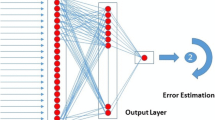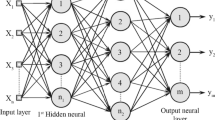Abstract
In this study, evaluation and prediction of rock cohesion is assessed using multiple regression as well as group method of data handling (GMDH). It is a well-known fact that cohesion is the most crucial rock shear strength parameter, which is a key parameter for the stability evaluation of some geotechnical structures such as rock slope. To fulfill the aim of this study, a database of three model input parameters, i.e., p wave velocity, uniaxial compressive strength and Brazilian tensile strength and one model output, which is cohesion of limestone samples was prepared and utilized by GMDH. Different GMDH models with neurons and layers and selection pressure were tested and assessed. It was found that GMDH model number 4 (with 8 layers) shows the best performance among all of tested models between the input and output parameters for the prediction and assessment of rock cohesion with coefficient of determination (R2) values of 0.928 and 0.929, root mean square error values of 0.3545 and 0.3154 for training and testing datasets, respectively. Multiple regression analysis was also performed on the same database and R2 values were obtained as 0.8173 and 0.8313 between input and output parameters for the training and testing of the models, respectively. The GMDH technique developed in this study is introduced as a new model in field of rock shear strength parameters.







Similar content being viewed by others
References
Armaghani D, Hajihassani M, Bejarbaneh B, Marto A (2014) Indirect measure of shale shear strength parameters by means of rock index tests through an optimized artificial neural network. Measurement 55:487–498
Alejano LR, Carranza-Torres C (2011) An empirical approach for estimating shear strength of decomposed granites in Galicia, Spain. Eng Geol 120:91–102
Zorlu K, Gokceoglu C, Ocakoglu F et al (2008) Prediction of uniaxial compressive strength of sandstones using petrography-based models. Eng Geol 96:141–158
Mohamad ET, Armaghani DJ, Momeni E et al (2016) Rock strength estimation: a PSO-based BP approach. Neural Comput Appl. https://doi.org/10.1007/s00521-016-2728-3
Jahed Armaghani D, Mohd Amin MF, Yagiz S et al (2016) Prediction of the uniaxial compressive strength of sandstone using various modeling techniques. Int J Rock Mech Min Sci 85:174–186. https://doi.org/10.1016/j.ijrmms.2016.03.018
Armaghani DJ, Safari V, Fahimifar A et al (2017) Uniaxial compressive strength prediction through a new technique based on gene expression programming. Neural Comput Appl 30:3523. https://doi.org/10.1007/s00521-017-2939-2
Bejarbaneh BY, Bejarbaneh EY, Fahimifar A et al (2018) Intelligent modelling of sandstone deformation behaviour using fuzzy logic and neural network systems. Bull Eng Geol Environ 77:345–361
Monjezi M, Khoshalan H, Razifard M (2012) A neuro-genetic network for predicting uniaxial compressive strength of rocks. Geotech Geol Eng 30:1053–1062
Liu H, Kou S, Lindqvist P, Tang C (2004) Numerical studies on the failure process and associated microseismicity in rock under triaxial compression. Tectonophysics 384:149–174
Barla G, Barla M, Debernardi D (2010) New triaxial apparatus for rocks. Rock Mech Rock Eng 43:225–230
Sarout J, Molez L, Guéguen Y, Hoteit N (2007) Shale dynamic properties and anisotropy under triaxial loading: experimental and theoretical investigations. Phys Chem Earth Parts A/B/C 32:896–906
Kahraman S, Altun H, Tezekici BS, Fener M (2006) Sawability prediction of carbonate rocks from shear strength parameters using artificial neural networks. Int J Rock Mech Min Sci 43:157–164
Amann F, Kaiser P, Button EA (2012) Experimental study of brittle behavior of clay shale in rapid triaxial compression. Rock Mech Rock Eng 45:21–33
Chong KP, Chen J-L, Dana G, Sailor S (1984) Triaxial testing of devonian oil shale. J Geotech Eng 110:1491–1497
Asadi M, Bagheripour MH (2014) Numerical and intelligent modeling of triaxial strength of anisotropic jointed rock specimens. Earth Sci Inform 7:165–172
Li D, Xiao P, Han Z, Zhu Q (2018) Mechanical and failure properties of rocks with a cavity under coupled static and dynamic loads. Eng Fract Mech. https://doi.org/10.1016/j.engfracmech.2018.10.021
Zhu Q, Li D, Han Z et al (2019) Mechanical properties and fracture evolution of sandstone specimens containing different inclusions under uniaxial compression. Int J Rock Mech Min Sci 115:33–47
Iannacchione AT, Vallejo LE (2000) Shear strength evaluation of clay–rock mixtures. In: Proceedings of the slope stability 2000, Denver, 3–6 August 2000, American Society of Civil Engineers, pp 209–223
Singh M, Raj A, Singh B (2011) Modified Mohr–Coulomb criterion for non-linear triaxial and polyaxial strength of intact rocks. Int J Rock Mech Min Sci 48:546–555
Barton N (1976) The shear strength of rock and rock joints. Int J Rock Mech Min Sci Geomech Abs 13:255–279
Hajdarwish A, Shakoor A (2006) Predicting the shear strength parameters of mudrocks. In: Proceedings of the 10th IAEG congress, Nottingham, 6–10 September 2006. The Geological Society of London, London, p 7
Hoek E, Carranza-Torres C, Corkum B (2002) Hoek-Brown failure criterion-2002 edition. Proc NARMS Tac 1:267–273
Yazdani B (2012) Shear strength parameters of shale based on triaxial compression test. Universiti Teknologi Malaysia, Malaysia
Ghazvinian A, Vaneghi RG, Hadei MR, Azinfar MJ (2013) Shear behavior of inherently anisotropic rocks. Int J Rock Mech Min Sci 61:96–110
Islam MA, Skalle P (2013) An experimental investigation of shale mechanical properties through drained and undrained test mechanisms. Rock Mech Rock Eng 46:1391–1413
Barton N (2013) Shear strength criteria for rock, rock joints, rockfill and rock masses: problems and some solutions. J Rock Mech Geotech Eng 5:249–261
Koopialipoor M, Armaghani DJ, Haghighi M, Ghaleini EN (2017) A neuro-genetic predictive model to approximate overbreak induced by drilling and blasting operation in tunnels. Bull Eng Geol Environ. https://doi.org/10.1007/s10064-017-1116-2
Liao X, Khandelwal M, Yang H et al (2019) Effects of a proper feature selection on prediction and optimization of drilling rate using intelligent techniques. Eng Comput. https://doi.org/10.1007/s00366-019-00711-6
Koopialipoor M, Fallah A, Armaghani DJ et al (2018) Three hybrid intelligent models in estimating flyrock distance resulting from blasting. Eng Comput. https://doi.org/10.1007/s00366-018-0596-4
Hasanipanah M, Armaghani DJ, Amnieh HB et al A risk-based technique to analyze flyrock results through rock engineering system. Geotech Geol Eng 36:2247–2260
Armaghani DJ, Mohamad ET, Momeni E, Monjezi M, Narayanasamy MS (2016) Prediction of the strength and elasticity modulus of granite through an expert artificial neural network. Arab J Geosci 1:48–64
Koopialipoor M, Armaghani DJ, Hedayat A et al (2018) Applying various hybrid intelligent systems to evaluate and predict slope stability under static and dynamic conditions. Soft Comput. https://doi.org/10.1007/s00500-018-3253-3
Zhao Y, Noorbakhsh A, Koopialipoor M et al (2019) A new methodology for optimization and prediction of rate of penetration during drilling operations. Eng Comput. https://doi.org/10.1007/s00366-019-00715-2
Koopialipoor M, Fahimifar A, Ghaleini EN et al (2019) Development of a new hybrid ANN for solving a geotechnical problem related to tunnel boring machine performance. Eng Comput. https://doi.org/10.1007/s00366-019-00701-8
Koopialipoor M, Murlidhar BR, Hedayat A et al (2019) The use of new intelligent techniques in designing retaining walls. Eng Comput. https://doi.org/10.1007/s00366-018-00700-1
Ivakhnenko AG (1971) Polynomial theory of complex systems. IEEE Trans Syst Man Cybern 1:364–378
Haykin S (1999) Neural networks: a comprehensive foundation. Prentice Hall, Upper Saddle River
Kalantary F, Ardalan H, Nariman-Zadeh N (2009) An investigation on the Su–NSPT correlation using GMDH type neural networks and genetic algorithms. Eng Geol 104:144–155
Kordnaeij A, Kalantary F, Kordtabar B, Mola-Abasi H (2015) Prediction of recompression index using GMDH-type neural network based on geotechnical soil properties. Soils Found 55:1335–1345
Najafzadeh M, Barani G-A, Kermani MRH (2013) GMDH based back propagation algorithm to predict abutment scour in cohesive soils. Ocean Eng 59:100–106
Koopialipoor M, Nikouei SS, Marto A et al (2018) Predicting tunnel boring machine performance through a new model based on the group method of data handling. Bull Eng Geol Environ. https://doi.org/10.1007/s10064-018-1349-8
Ulusay R, Hudson JA, ISRM (2007) The complete ISRM suggested methods for rock characterization, testing and monitoring: 1974–2006. In: Ulusay R, Hudson JA (eds) Suggested methods prepared by the commission on testing methods. International Society for Rock Mechanics. ISRM Turkish National Group, Ankara, Turkey
Hatheway AW (2009) The complete ISRM suggested methods for rock characterization, testing and monitoring; 1974–2006. Springer, Berlin
Bieniawski ZT, Bernede MJ (2007) Suggested methods for determining the uniaxial compressive strength and deformability of rock materials: part 1. Suggested method for determining deformability of rock materials in uniaxial compression. In: Ulusay R, Hudson JA (eds) The complete ISRM suggested methods for rock characterization, testing and monitoring: 1974–2006. Pergamon
Jaeger JC (1967) Failure of rocks under tensile conditions. Int J Rock Mech Min Sci Geomech Abs 4(2):219–227
Khandelwal M, Singh TN (2007) Evaluation of blast-induced ground vibration predictors. Soil Dyn Earthq Eng 27:116–125
Ghaleini EN, Koopialipoor M, Momenzadeh M et al. (2018) A combination of artificial bee colony and neural network for approximating the safety factor of retaining walls. Eng Comput. https://doi.org/10.1007/s00366-018-0625-3
Kato T, Otsubo T, Shimazaki K et al (2018) Tool wear estimation method in milling process using air turbine spindle rotation-control system equipped with disturbance force observer. Int J Hydromechatron 1:384–402
Johnson JL (2018) Design of experiments and progressively sequenced regression are combined to achieve minimum data sample size. Int J Hydromechatron 1:308–331
Zhang S, Iwashita H, Sanada K (2018) Thermal performance difference of ideal gas model and van der Waals gas model in gas-loaded accumulator. Int J Hydromechatron 1:293–307
Koopialipoor M, Ghaleini EN, Haghighi M et al (2018) Overbreak prediction and optimization in tunnel using neural network and bee colony techniques. Eng Comput. https://doi.org/10.1007/s00366-018-0658-7
Gordan B, Koopialipoor M, Clementking A et al (2018) Estimating and optimizing safety factors of retaining wall through neural network and bee colony techniques. Eng Comput. https://doi.org/10.1007/s00366-018-0642-2
Jahed Armaghani D, Hajihassani M, Monjezi M et al (2015) Application of two intelligent systems in predicting environmental impacts of quarry blasting. Arab J Geosci. https://doi.org/10.1007/s12517-015-1908-2
Hasanipanah M, Jahed Armaghani D, Monjezi M, Shams S (2016) Risk assessment and prediction of rock fragmentation produced by blasting operation: a rock engineering system. Environ Earth Sci. https://doi.org/10.1007/s12665-016-5503-y
Acknowledgements
The authors would like to express their sincere appreciation to reviewers because of their valuable comments that increased the quality of our paper.
Author information
Authors and Affiliations
Corresponding author
Additional information
Publisher’s Note
Springer Nature remains neutral with regard to jurisdictional claims in published maps and institutional affiliations.
Rights and permissions
About this article
Cite this article
Chen, W., Khandelwal, M., Murlidhar, B.R. et al. Assessing cohesion of the rocks proposing a new intelligent technique namely group method of data handling. Engineering with Computers 36, 783–793 (2020). https://doi.org/10.1007/s00366-019-00731-2
Received:
Accepted:
Published:
Issue Date:
DOI: https://doi.org/10.1007/s00366-019-00731-2




